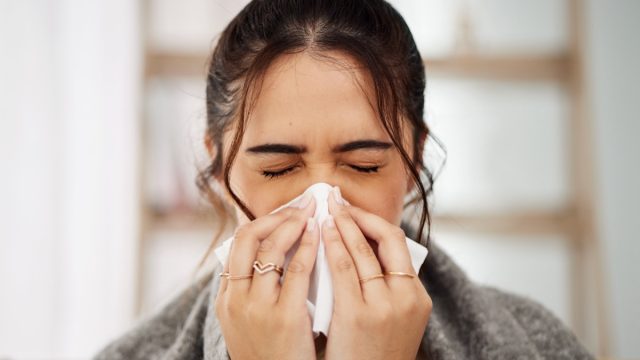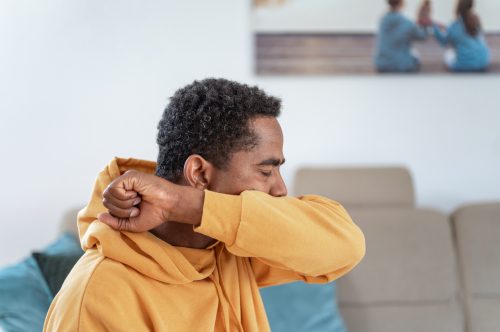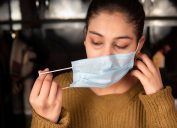COVID JN.1 Now Accounts for 86 Percent of Cases—These Are the Symptoms
The dominant variant could produce some different signs of sickness.

News of spiking COVID cases and new variants is always somewhat distressing, especially during cold and flu season when it feels like everyone around us is getting sick. If you've been keeping up with the latest COVID trends, odds are you've heard of JN.1, which established itself as the dominant variant late last year. Now, in a Jan. 22 announcement, the Centers for Disease Control and Prevention (CDC) revealed that JN.1 is causing even more trouble: As of Jan. 19, the variant accounted for approximately 85.7 percent of cases in the U.S.
JN.1's prevalence is up from two weeks ago, when it accounted for 55 to 68 percent of all circulating SARS-CoV-2 variants, and from early Dec. 2023, when it accounted for 15 to 29 percent, per CDC data.
Overall, COVID activity is high as well, particularly in the eastern part of the country, the agency added in the Jan. 22 announcement. Infections, hospitalizations, and deaths have been consistently elevated in recent weeks.
While the CDC says there's no evidence to suggest that JN.1 causes more severe disease than other COVID variants, the agency also notes that it is certainly contributing to the spread of the virus this winter.
COVID symptoms can vary depending on your overall immunity and health, rather than the variant, the CDC says. But in recent months, there have also been reports of more unusual symptoms. So, if you start to feel under the weather, take stock of how you're feeling—some symptoms might point to COVID, but you might not immediately connect others to the virus. Read on to find out what you need to look out for.
RELATED: COVID Now Causing These Unusual Symptoms, New Data Shows.
1
Anxiety

Recent data from the U.K. Office for National Statistics (ONS) identified anxiety as a potential COVID symptom, with 10.5 percent of survey respondents reporting worry or anxiety in early Dec. 2023.
2
Insomnia

Another symptom uncovered in the ONS survey was insomnia, with 10.8 percent of respondents reporting struggling to sleep.
The CDC acknowledged these findings earlier this month, stating that both insomnia and anxiety may now be symptoms of COVID in general, as opposed to JN.1 exclusively.
"There have been reports that COVID-19 may be associated with insomnia and anxiety in some patients, and therefore that can be a general symptom of infection and not related to the variant," the agency spokesperson previously told Best Life. "[The] CDC is constantly researching the effects of COVID variants and will update the public as we learn more."
(It should also be noted that the U.K. data didn't break results down by variant, so it's impossible to say whether the symptoms were directly connected to JN.1. Researchers also acknowledged that participants reported symptoms "regardless of the cause and testing status," meaning there's a chance they weren't directly related to COVID.)
RELATED: These Are the 9 Symptoms of the New JN.1 COVID Variant, Doctors Say.
3
Sore throat

A sore throat is typically the first indicator of a COVID-19 infection these days, experts say. In addition, in Dec. 2023, doctors said that a sore throat continues to be one of the more common COVID signs, per Parade.
4
Congestion

After a sore throat clears up, congestion typically settles in as the second main symptom of COVID, William Schaffner, MD, a professor of infectious diseases at Vanderbilt University Medical Center, told Parade last month.
5
GI symptoms

There are also a few gastrointestinal symptoms of COVID, including nausea, vomiting, and diarrhea. According to Michael Benninger, MD, otolaryngologist at the Cleveland Clinic, these signs are good differentiators between COVID and other illnesses.
"COVID-19 can also cause GI symptoms, like nausea, vomiting and diarrhea that aren't typical of the common cold or allergies," Benninger told Cleveland Clinic Health Essentials.
6
Loss of smell and taste

The loss of smell and taste was a giveaway for COVID during the early days. Today, it's still not a great sign—so if you notice something's off, it's probably time to take a test.
According to Benninger, loss of smell and taste is also less likely to result from a cold or allergies. They may cause minor changes, but significant decreases are much more likely to be COVID.
RELATED: 2 COVID Symptoms Now Tied for Most Common Virus Signs, Doctors Say.
7
Dry cough

Another strong COVID sign at the start of the pandemic was a cough. This still rings true today, and according to Cleveland Clinic Health Essentials, a cold isn't as likely to cause this (although allergic asthma can).
A wet cough typically isn't a sign of COVID-19, per the Cleveland Clinic.
8
Fever and chills

Running a bit of a fever or struggling with the chills? These are two other indicators of COVID, but as with the rest of the symptoms, you might have these, or you might not.
"For some people, COVID-19 causes fever and chills, though that's not always the case," Benninger told Cleveland Clinic Health Essentials.
A list of additional COVID-19 symptoms can be found on the CDC's website, although the agency notes it does not include all possible symptoms. If you're feeling sick, experts urge you to get tested for COVID-19.
RELATED: For more up-to-date information, sign up for our daily newsletter.
Best Life offers the most up-to-date information from top experts, new research, and health agencies, but our content is not meant to be a substitute for professional guidance. When it comes to the medication you're taking or any other health questions you have, always consult your healthcare provider directly.





















